#Spanische Hofreitschule
Text

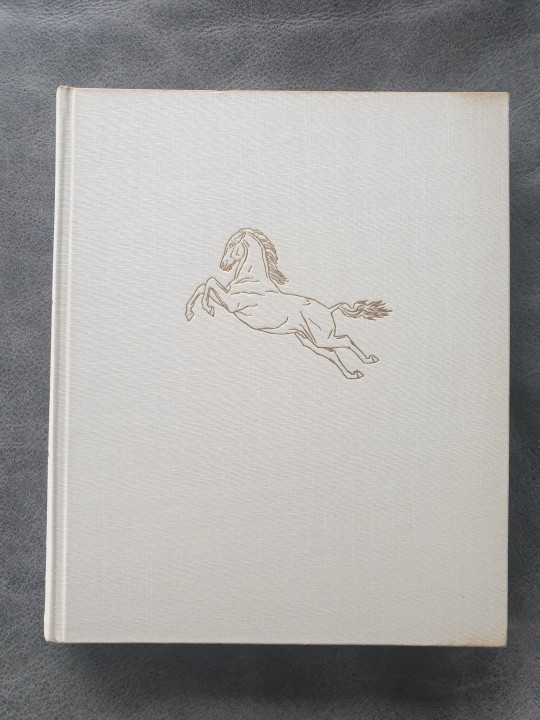
I got this book "Triumph der Lipizzaner" from 1962 off the austrian equivalent of ebay and i had so share some stuff.
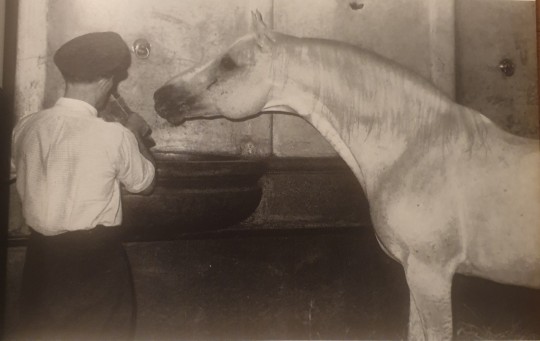
this guys name is Favory Kitty and from now on my favourite Lipi
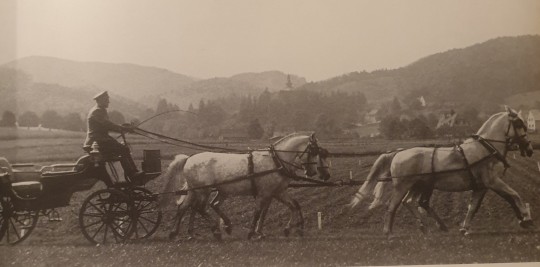
mares completing their driving training before they're allowed to be used for breeding but look how synchronised
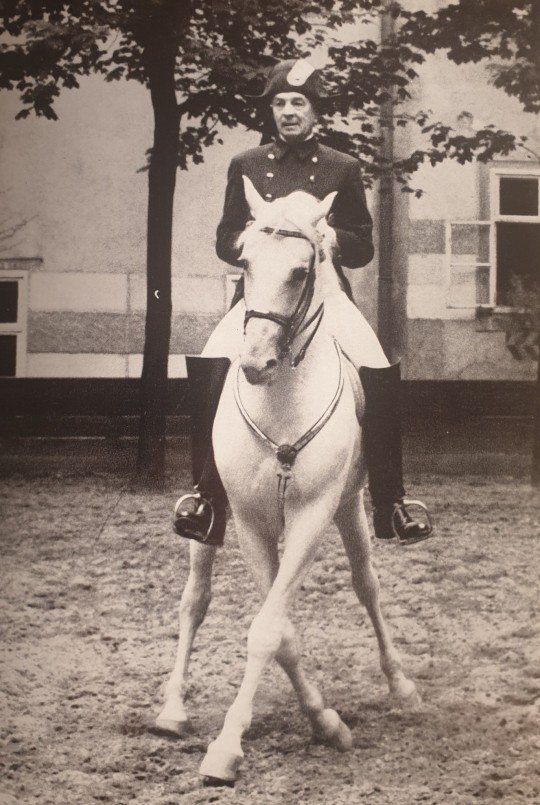
Apparently they dont start with ridden gallop work until the horses are balanced enough through all the lateral work.

stallion does some modelling for a statue

First day back in the Vienna ridingschool in Oktober 1955 after a 10 year exile started during ww2

Either Maestoso Alea or Maestoso Mercurio in extended trot
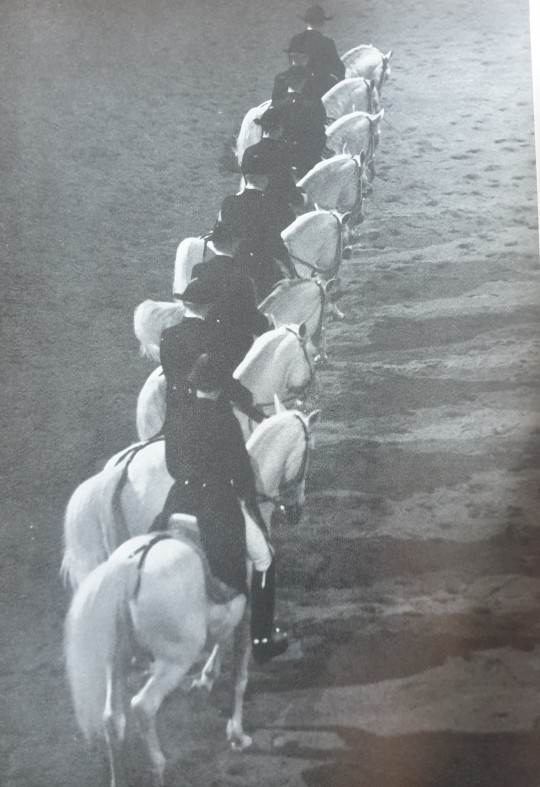
okay that was it with the spam for now :D
Post about the history of the Spanish Riding School
480 notes
·
View notes
Video
youtube
Dancing Horses (1946)
Thought to be Selected Originals from late 1940s material.
Wels, Austria. Austrian voiceovered newsreel material.
Horses from the Vienna's Spanish Riding Academy practise their dancing.
Horses of the famous Vienna's Spanish Riding Academy are put through their paces in their new home at Wels. They dance forward and past each other. The star performer, a white Lipizzaner stallion, goes through its dancing paces, it stands on its hind legs and then performs a Courbette.
#video#British Pathé#Lipizzaner#1946#Spanish Riding School#haute école#pferd#Spanische Hofreitschule#hengst#stallions
18 notes
·
View notes
Text


definitely not the worst place I've ever worked at
10 notes
·
View notes
Text
Vienna - Historic Center

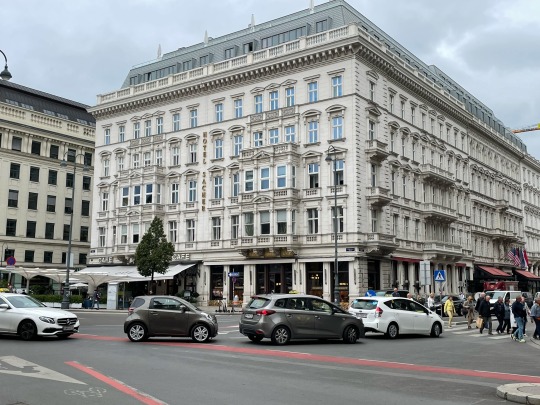


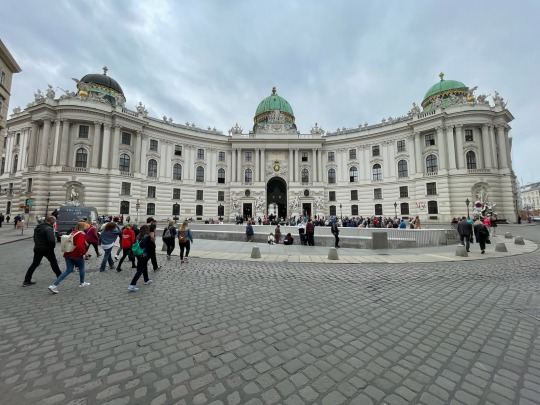
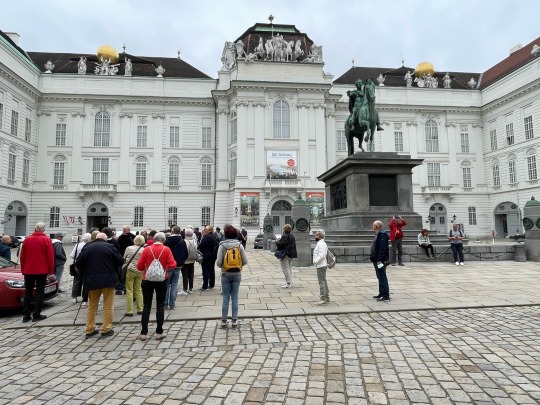



#traveling#reisen#austria#vienna#österreich#wien#opera#oper#hotel sacher#albertina#spanish riding school#spanische hofreitschule#hofburg#st stephens dome#stephansdom
1 note
·
View note
Photo

Cool spring outfit in mixed style of late 19th & of 20th
#vintage#vintage photography#vintage fashion#vintage style#vintage hat#Retro#retro fashion#retro style#retro look#retro inspired#19th fashion#20th fashion#Mayser creation#Mayser#felt hat#fur felt hat#Spanische Hofreitschule Wien#Spanische Hofreitschule#Remo Salvador#ReVolt#Earth squared Edinburgh#Earth squared#Dannais#Dannais dde Daneann#Dannais dde Danenn#Alexandrina Wasiliewa-Szylowska#Alexandrina Wasiliewa-Szyłowska#Italian style
0 notes
Text
Speaking of which, Edwige saying she preferred the theatre in an interview at the Cannes Film Festival and me having subconscious knowledge of this caused an accidental parallel in my final spoken German exam where I was asked what I wanted to do after college -- move to Germany, for example -- and I said, all too honestly, "nah i wanna move to France"
#the two examiners raised their eyebrows and were like 'well do you speak french??' bc i didn't study it in main degree#and i was like 'a little' and then idk i started talking about theatre and vibes or something#but basically the gist of that section of the exam was 'everything i have studied at university formally has nothing to do#with what i really want to do in life' and that only struck me afterwards XD 💀💀💀#it was defo a slight suckerpunch for the examiners it was so funny#but it was well known in the dept i think that i wanted to do theatre bc i literally would not stfu about it in that final year of college#FOR THE RECORD I did say I was considering to live in Vienna for a while so I DID RECOVER THE VIBE#and i spoke ab my interest in Elisabeth of Austria and the vibes of Vienna#and then after the exam ended the main examiner was like 'omg i remember bumping into you at the Spanische Hofreitschule'#AND THAT WAS BACK IN MARCH 2019#i was so stunned but yeah turns out i guess she shared the interest in Sisi and the Hofreitschule#i was amazed she remembered but it's something that has stayed with me in my heart <3#roacc#also i totally was chancing my arm bc i wanted to shift the power dynamic in my favour immediately the moment i entered the room#and i stupidly said 'wow it's so sunny out today!' instead of 'bright' bc the sun had since disappeared but the room was swathed#in natural light#but thankfully neither of them turned back to check the massive windows lmfao 💀 so they cheerfully agreed and moved on
1 note
·
View note
Link
0 notes
Text
Aph Austria x Spain Headcanon
I’ve been lately thinking about Spain and Austria, because it is shocking (not really) that there’s so little content about them and that most people don’t even think of them as a couple (it is even listed as a “rare pairing” in Hetalia wiki), given it is one of the few stablished official pairs in Hetalia, to the point they’re shown to be married (and no, I don’t mean having an alliance, or cooperating, I mean, it is indeed stablished they were a married couple).
Tbh, this ship was not particularly appealing to me either, even though I usually like my ships to be historical, and you can hardly get much more historical than a Spain/Austria ship. I’ve always thought their personalities and tastes appeared to be too different to match. And no, I did not buy into the initial portrayal of Spain as a total airhead, happy-go-lucky, relaxed and smily guy, but still, they didn't do it for me (though the fandom largely exaggerated such traits, as Spain is actually shown to be sad and disappointed, and as someone somewhat wise, in one of his early appearances in the show). I think I always thought of Roderich personality to be too over the top. It’s okay to be strict (like Ludwig is), but he just seemed to be way too strict, way too proper, way too desdainful, way too bland and dull, at all times. There must be more to him that what we are shown, right?
But I have these moments when I think about how actually close they were, and about Austrians’ rather good opinion on Spaniards even after their countries’ estrangement (and not in a good way, I must add). I think about how Austria tried to mimick the very strict rules of the Spanish Court (Spanisches Hofzeremoniell) and the way the Spanish dressed (Spanish fashion was widespread at the time, as was Spanish culture, and language, but was specifically imitated in the Austrian Court), how he valued Spain’s experience and knowledge when it came to equestrian tradition (Spanische Hofreitschule), and how he enjoyed and liked Spanish composers (like Vicente Martín y Soler), even decades after they had fallen apart. Austrians also seemed to have considered Spaniards to be intelligent and wise people, powerful, but benevolent in battle, well dressed, lordly behaved, and righteous. Ironically, they thought the vice of Spaniards to be arrogance and vanity (funny it is apparently Roderich who comes off as the arrogant one in Hetalia, though, truth be told, everyone at the time seem to have thought of the Spaniards as arrogant and/or vain).
All in all, it has become a headcanon of mine that Roderich probably became the way we know him AFTER being married to Spain. Yes, I know in canon he is shown to be already that snooty before meeting him, heck, it is even said he gave Southern Italy to Spain, when actually those territories had belong to the Spanish monarchs (Kingdom of Aragón) for almost a century before Spain and Austria became acquainted, and it is historically pure nonsense to even imply the Kingdoms of Sicily and Naples, and Sardinia, were granted to Spain by Austria, when Spain (really, the Spanish monarchs of the Kingdom of Aragón) even had control over Malta at the time (though it would lose it in 1530, soon after their “marriage”).
Making it simple, I headcanon Roderich to become as “stiff” as we know him to be during his marrige with Antonio. It is a classic case of “overdoing it” (in Spanish “tener la fé del converso”, o “ser más papista que el Papa”). We know Austrias’s way to climb the social ledder of countries and to hold on its position as a powerful and influential nation was through marriage. So he had to be good at that, he had to be up to his couple, up to what his couple may expect of him. So he became everything he thought Antonio valued. Spanish Court ceremonial was strict, so he would become the most severe of them all. Spanish people valued etiquette, so should he. Spanish fashion was over elaborated, and so was Austrias, and when the tides turned and French fashion was in, Austria would stick with certain elements of old Spanish dresscode for a bit longer (I’m thinking about the men's court dress of Austria in the 17th-18th centuries, the Spanish Mantelkleid). Spain was known for elegance, and so was Austria. Spain was precise, careful, a bit haughty in his behaviour and mannerism, and more so ought to be Austria. All in all, Austria modelled himself to became the “perfect” match for Spain, at least for the Spain he knew.
I think Roderich took into this character part to please Antonio, part out of duty for his people, and part because it suited his interests and tastes. While Antonio slowly loosened up, Roderich made this new image his own, for he was comfortable with it and it suited him well. I don't think Antonio was ever unwilling to show a severe self image, I don't think his demeanour was a façade at all. It was no play, the sternness and haughty behaviour was genuine (if anything, it is his laid-back attitude and overly smily self that is, albeit not completly fake, a bit of a façade, for although he is of a cheerful and optimistic nature, time has worn down his optimism and has pushed him to the limits of his sanity more than once). But I do think he naturally softened and relaxed quite a lot when not "in duty", so to speak (relaxed as in less composed, showing more his emotions, expressing his feelings, fears, and needs, I actually think he must have been half paranoid most of the time). Roderich did too, but became so attached to his image of tidiness that it became a bit harder for him to let go, hence the contrast between him and Antonio, more so in modern times.
For whatever reason, imagining Roderich’s personality taking its final form during his 200 years relationship with Antonio makes sense to me, and makes me like and appreciate the pairing quite a lot. I guess I was just missing some more information on Roderich’s behaviour and personality.
I hope that no one takes offence by my take on Roderich personality and its evolution. I’m well aware Austria has a very rich history, and I do not intend to make Spain the corner stone of Roderich’s identity, it is just that I was missing some “origin story” for Roderich, some explanation for his character. And it makes sense Antonio played a very important role in his life, given they got stuck together for 200 years while in their late teens/early adulthood, while still finding themselves out, and the ending of their relationship was a war involving several countries and power houses in Europe, during which Austria was just not willing to give up, and Spain went through a rough civil war (and probably an emotional turmoil, worrying and being suspicious of Roderich's, and mostly Francis', intentions).
#aph spain#aph austria#antonio fernández carriedo#roderich edelstein#spaus#aph#hetalia#also#I had no idea#a friend of mine is visiting spain this summer and we're going to visit the royal palace of madrid#and i was planning to take a peek at the Royal Armoury as I had read it was one of the best#and most important collections of its kind in the world#i was looking at the official webpage today and just read the other one that matches its importance is in Vienna#lol#so great#but yeah#i love in the show we see Spain getting exited about an old sword that Romano gave to him#and Romano commenting on Spain's interest and love for old weapons#i think it was a roman sword#not surprised Antonio was so exited#I would have been too
29 notes
·
View notes
Note
Heyooo ☺️ Ich werde für Harrys Konzert in Wien sein und hab gleich noch einige Tage in Wien für Stadtferien angehängt :)
Hast du irgendwelche (Insider-)Tipps, was ich tun könnte? Z.B. Cafés oder Restaurants, oder Museen, die du magst (und es darf ruhig auch ein wenig ausserhalb der Stadt sein). Ich war vor einigen Jahren schon mal in Wien und hab rein theoretisch den ganzen hardcore Touristenkram bereits gesehen, aber falls du trotzdem irgendwelche „touristischen“ Tipps hast, sehe ich mir die natürlich auch gerne an :D
Danke im Voraus und ich wünsche dir noch einen wunderschönen Tag 🥰
uiiii ja let me try, jedes Mal wenn wer fragt is mein Kopf einfach leer hahaha
Cafes/ Restaurants: Siebenstern, Disco Volante, Liebling, Europa, Erich/ Ulrich, Propeller, Tata 7, Budapest Bistro, Swing Kitchen (bestes veganes Fastfood der Welt trust me), Edison, Budapest Bagel, Neni am Naschmarkt (Naschmarkt generell 10/10 da findest du immer irgendwas zu essen, auf das du Bock hast), Cafe Frida (auch generell Yppenplatz findet man auch immer was), Palmenhaus (pricey aber fancy), Veganista für tiptop Eis
Museen kann ich immer das naturhistorische Museum, MUMOK und Albertina empfehlen, generell is es ne gute Route wenn man zum Beispiel am Museumsquartier startet und dann bis zur spanisches Hofreitschule durchgeht, da nimmt man viele Sehenswürdigkeiten mit und das is ein guter Spaziergang. Sonst noch Burggarten oder auf die Gloriette raus (in Schönbrunn rein muss man echt nicht, das lohnt sich nicht) und wir haben auch einen echt schönen botanischen Garten am Belvedere, am Burggarten ist auch das Schmetterlingshaus, das ich mega süss finde. Wenn das Wetter gut is kannst du gut an die alte Donau (dort kann man auch baden) oder auf den Donaukanal, dort is es einfach relativ chillig zum sitzen und was trinken. Prater is auch cool, selbst wenn man mit nichts fahren will is es gut zum einfach mal durchgehen und anschauen.
Ich würde halt alle so mega touri mäßigen Restaurants und Cafes wie Central oder Sacher auslassen, das lohnt sich meiner Meinung nach wirklich null.
7 notes
·
View notes
Link
Check out this listing I just added to my Poshmark closet: Spanische Hofreitschule Black Red White Soldiers W/ Horses Scarf.
0 notes
Text
I found this old book, so heres some more history on the Spanish Riding School Vienna.
(Also I dont understand how to put two pics next two eachother in a text post so pls bear with me, this is long)
Origin:
In 1565 a “Roßtumblplatz”, an open-air riding and tournament arena was built right next to the Hofburg palace in Vienna. Later a wooden indoor arena was added called “Spanische Reithsall”. In 1683 the first proper building for a riding school was built by Emperor Leopold I, but as a result of the second Turkish invasion it was heavily damaged before even completed.
Emperor Karl VI started building a new winter riding school in its place in 1729. The architect was Johann Bernhard Fischer von Erlach and it was built by his son Emanuel Fischer von Erlach. The Spanish Riding School as we know it today was finished in 1735.

Cross section of the Spanish Riding School drawn by one of the two Fischer von Erlachs.
Early History:

This is a drawing of a horse carousel from the 2. January 1742, with Empress Maria Theresia in the middle (figure in black to the left I think) with the Spanish Riding School in the back. She was a fan of horse carousels and often had them held.

But the Spanish Riding School was not only used for horse-related stuff. For example in 1814 Ludwig van Beethoven conducted a concert with 1000 musicians (1st pic), during the Vienna Congress after the Napoleonic Wars it was used for countless festifities and grand balls and in 1848 after the revolution it was used for the first Reichstag of the Monarchy (2nd pic).
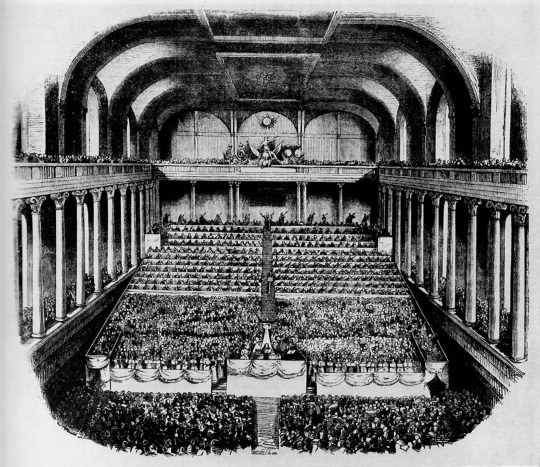

Then for a while nothing really happened. In 1898 all the knowledge the Spanish Riding School had, called “Directiven” was written down for the first time by Field Marshal Franz Holbein and Chief Rider Johann Meixner, up until that point all knowledge was passed on via word of mouth. World War I did not impact it that much (it did impact the breeding of Lipizzaner, but not the school itself).
World War II:
Shortly before the end of WWII the aereal war got too close to the Spanish Riding School and it was evacuated to Sankt Martin (Upper Austria). We all know how WWII went for Austria so it is no surprise that Upper Austria was not much safer.
With a very improvised, yet successful show, Colonel Alois Podhajsky (left, Chief of the Spanish Riding School from 1939-1964) managed to convince General George Patton (right) of the nearing US army to protect the horses and Spanish Riding School on 7. May 1945.

The building of the Spanish Riding School survived the aereal attacks, but with the horses gone it was used as a storage space for the federal thearters. Note that the huge crystal chandeliers are missing. They were taken down during the war and walled in, in order to protect them from looters.
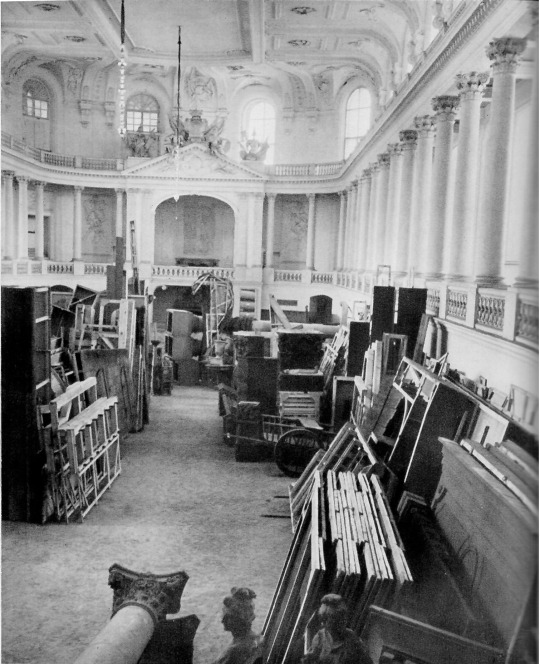
Exile:
The horses and school moved to Wels (still Upper Austria) but were not allowed back to Vienna. Over the next 10 years (they call it Exile) the Spanish Riding School travelled the globe and performed in various contries such as:
1948, Thun, Swizerland as a thank you for the Caritas efforts to protect austrian chidren during the war.

In 1950 they travel to thw United Stated, as a thank you to General Pattons protection and perform at shows in Harrisburg and New York, before moving on to Canada.

1951 in Kopenhagen. 1952 multiple shows in Stockholm. 1953 and 1954 several performances in Germany (Aachen (1st pic) and Dortmund), London and Spain (Sevilla) with an audience of 20.000 people (2nd pic).
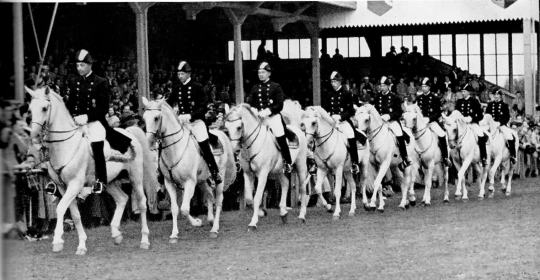
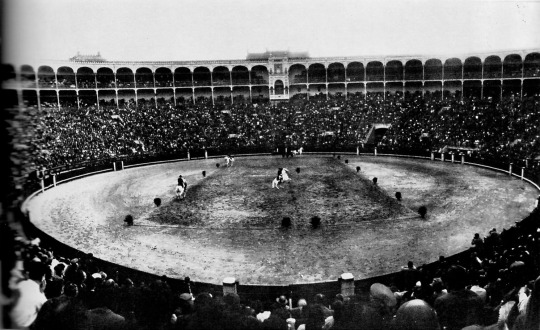
Back in Vienna:
With the end of the occupation of Austria and the finalization of the Austrian State Treaty in 1955 the stallions and Spanish Riding School were finally able to return to Vienna. On the 26. October 1955 they officially returned from their Exile with a festive perfromance. Everything returned back to normal.

This book was published in 1962 so the last piece of history in it shows filming work for the movie “Das Wunder der Weißen Hengste”/”Miracle of the White Stallions” which came out in 1963 and was produced by Walt Disney.



This book was written by the before mentioned Colone Podhajsky and has a lot of other gems about the school and the Lipizzaner which i will show in a different post and also has a really nice section on the history of classical dressage which I will also try to show in a seperate post.
#long post#Lipizzaner#Spanish Riding School#Vienna#Spanische Hofreitschule#history#ill link the pther posts I mentioned once I actually do them#:D
6 notes
·
View notes
Text
Spanische Hofreitschule

Spanische Hofreitschule
Die Spanische Hofreitschule Wien: Ein Meisterwerk der ReitkunstDie Spanische Hofreitschule in Wien ist nicht nur eine der ältesten Reitschulen der Welt, sondern auch ein wahrhaftiges Juwel für Liebhaber der Reitkunst und Kultur. In diesem Blogbeitrag werden wir uns eingehend mit der Geschichte, den Ausstellungen, den Besonderheiten und den regelmäßigen Veranstaltungen dieser einzigartigen Institution befassen.Die Geschichte der Spanischen HofreitschuleDie Wurzeln der Spanischen Hofreitschule reichen zurück bis ins 16. Jahrhundert, als Erzherzog Maximilian II. sie im Jahr 1565 gründete. Seitdem hat die Schule eine beeindruckende Geschichte durchlebt, von kaiserlichen Höfen bis hin zu modernen Zeiten. Die Tradition der klassischen Dressur, insbesondere der Lipizzaner, wurde hier über die Jahrhunderte hinweg bewahrt und weiterentwickelt.Die Kunst der Dressur: Einblick in die AusstellungenDie Spanische Hofreitschule ist nicht nur eine Schule, sondern auch ein lebendiges Museum der Reitkunst. In den Ausstellungen werden historische Sättel, Zaumzeug und andere Reitausrüstungen präsentiert. Besucher können in die faszinierende Welt der klassischen Reitkunst eintauchen und die Entwicklung der Ausrüstung im Laufe der Jahrhunderte verfolgen. Die Ausstellungen bieten einen einzigartigen Einblick in die Verbindung zwischen Reiter und Pferd.Die Besonderheiten der Spanischen HofreitschuleEin besonderes Merkmal der Spanischen Hofreitschule sind zweifellos die Lipizzaner, eine seltene und edle Pferderasse. Die eleganten Bewegungen dieser Pferde, kombiniert mit der präzisen Ausbildung der Reiter, schaffen eine Aufführung, die weltweit Bewunderung findet. Die Schule legt großen Wert auf die Erhaltung dieser traditionsreichen Pferderasse und trägt somit zur Bewahrung des kulturellen Erbes bei.Ein weiteres Highlight ist die barocke Architektur des Reitschulgebäudes selbst. Die prachtvollen Räumlichkeiten spiegeln die kaiserliche Geschichte wider und bieten eine passende Kulisse für die erhabenen Vorführungen.Veranstaltungen: Ein Erlebnis für Jung und AltDie Spanische Hofreitschule bietet das ganze Jahr über eine Vielzahl von Veranstaltungen für Besucher jeden Alters an. Die berühmten Galavorstellungen präsentieren die Höhepunkte der klassischen Dressur und zeigen die harmonische Beziehung zwischen Reiter und Pferd. Für diejenigen, die tiefer in die Materie eintauchen möchten, werden auch Führungen durch die Stallungen und die Reitschule angeboten. Diese ermöglichen es den Besuchern, die Pflege der Lipizzaner und die täglichen Abläufe der Schule aus nächster Nähe zu erleben.Mein persönliches FazitDie Spanische Hofreitschule in Wien ist zweifellos ein Ort von außergewöhnlicher Schönheit und kulturellem Wert. Die tief verwurzelte Geschichte, die beeindruckenden Ausstellungen, die edlen Lipizzaner und die mitreißenden Veranstaltungen machen diesen Ort zu einem Must-Visit für jeden, der sich für die Kunst der Dressur und die Verbindung zwischen Mensch und Pferd interessiert.Die Spanische Hofreitschule bewahrt nicht nur ein kulturelles Erbe, sondern schafft auch eine zeitlose Verbindung zwischen Vergangenheit und Gegenwart. Ihre Bedeutung erstreckt sich über die Grenzen Österreichs hinaus und inspiriert Menschen weltweit. Ein Besuch dieser einzigartigen Institution ist nicht nur eine Reise in die Vergangenheit, sondern auch eine Feier der Schönheit und Eleganz, die die Welt der Reitkunst zu bieten hat.
Öffnungszeiten
Die Spanische Hofreitschule in Wien ist von Montag bis Samstag von 10:00 bis 12:00 Uhr geöffnet. Die Vorführungen dauern 2 Stunden und beginnen um 10:00 Uhr. Der letzte Einlass ist um 9:30 Uhr.Bitte beachte, das die Öffnungszeiten hier nicht immer ganz aktuell sein könnten. Daher benutze bitte unten den Link "Offizielle Homepage" um genauere und aktuelle Öffnungszeiten zu erhalten.
Lageplan
Benutze bitte den direkten Link oben "Routenplaner" um Infos für die Erreichbarkeit usw. zu erhalten.
Weitere Infos
- Weitere Angebote für Wien
- Offizielle Homepage
- Adresse:Spanische HofreitschuleMichaelerplatz 1, 1010 WienOder suche hier weitere Vorschläge für dich
Wetter Wien
Über einen Kommentar würden wir uns sehr freuen. Erzähl uns wie es dir dort gefallen hat, oder ob es vielleicht ein Reinfall war.
Read the full article
#familienfreundlich#Lipizaner#Pferde#Regen#Schlechtwetter#Schönwetter#Sonne#SpanischeHofreitschule#Wien
0 notes
Photo

Escuela de caballos españoles de Viena. Exhibición ecuestre con música clásica. (at Spanische Hofreitschule) https://www.instagram.com/p/Chze0QboDWLIANeXnbyTAokwvVn7iKHliO6ooQ0/?igshid=NGJjMDIxMWI=
0 notes
Photo

Spanish Riding School (at Spanische Hofreitschule) https://www.instagram.com/p/CdbaGCArbfv/?igshid=NGJjMDIxMWI=
0 notes
Video
youtube
Austrian Horsemen AKA Australian Horsemen (1920-1929)
Location of events unknown - could be Vienna, Austria.
Horse shows. Austrian Lipizzaner horsemen in ceremonial uniforms riding beautiful white horses around indoor ring - probably at the Spanish Riding School in Vienna, Austria.
Horses lined up in street. CUs of the men and horses. Horses dance in the ring; stand up on hind legs. 5 horses lined up in row; crossing the ring.
Dressage.
Note: film is titled on paperwork as 'Australian Horsemen', but I think this is a mistake and should be 'Austrian Horsemen' - SL.
British Pathé
36 notes
·
View notes
